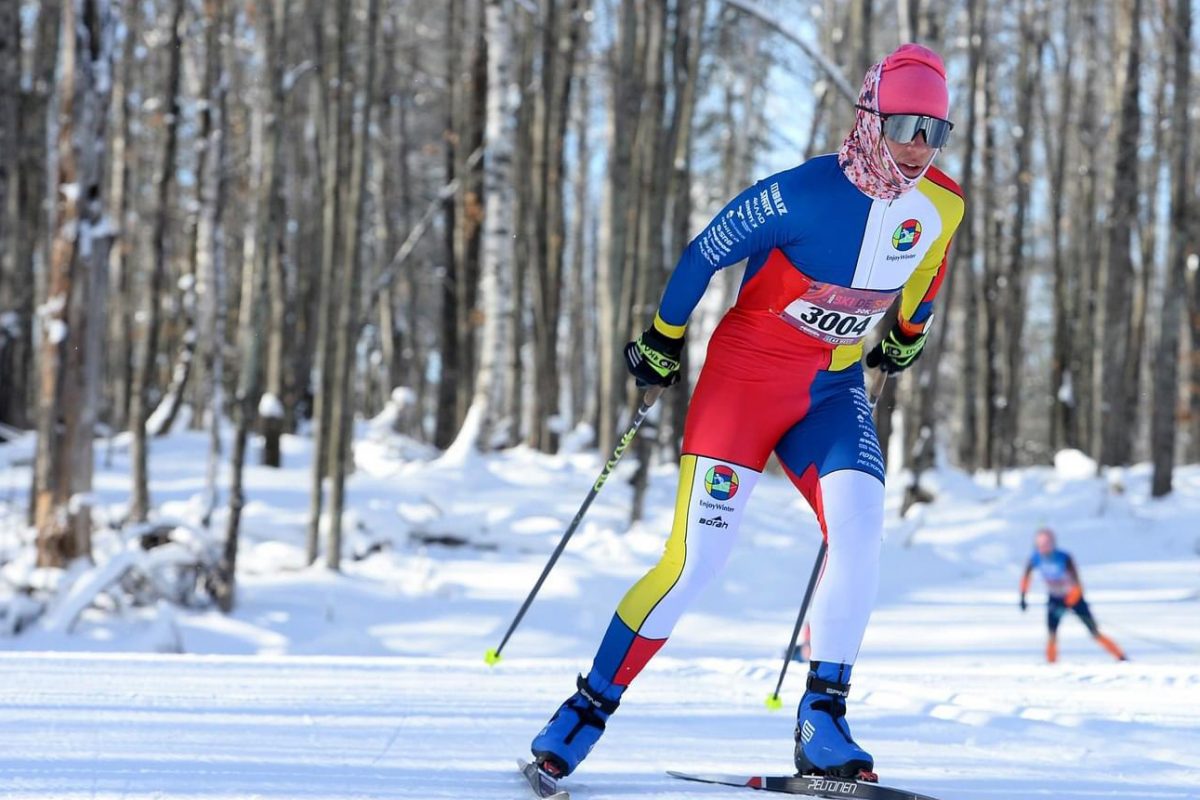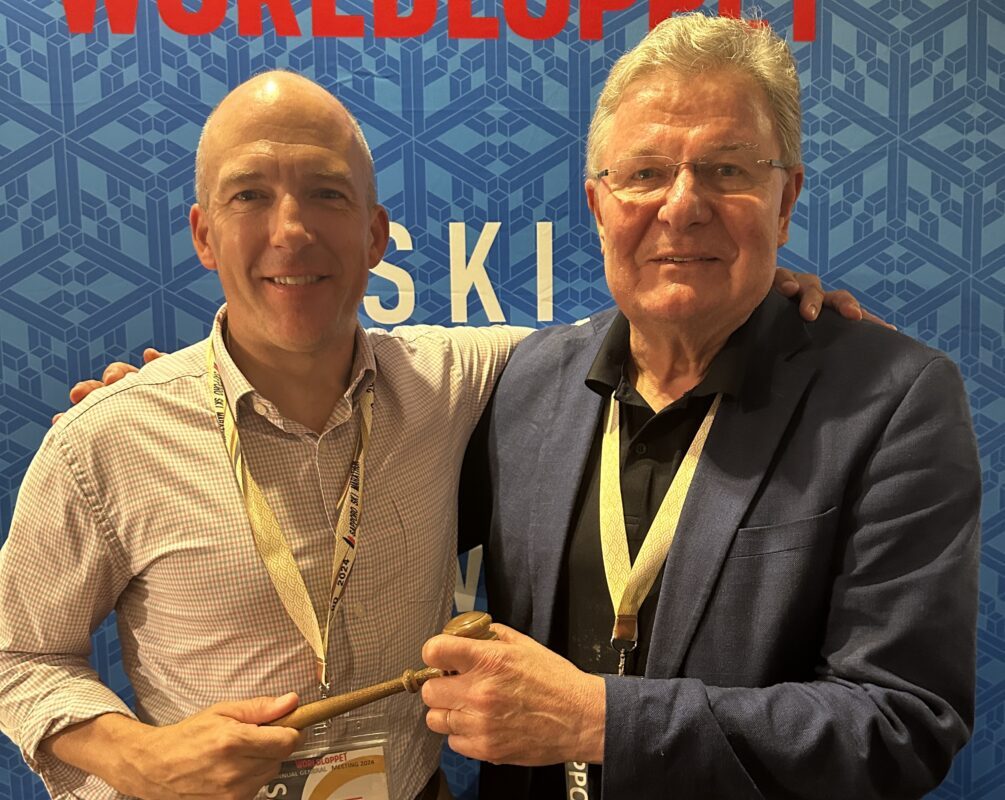On an overcast Sunday, Ricardo Izquierdo-Bernier and Emma Page were the men’s and women’s winners of the Climb to the Castle roller ski race. Both were first-time victors.
Izquierdo-Bernier, of the club Fondeurs-Laurentides north of Montreal, won in 39:06.5. Aidan Ripp, of Paul Smith’s College, finished second for the men in 41:17.0. Behind him, Parke Chapin of Green Mountain Valley School (GMVS) took third in his first Climb to the Castle, in 42:41.7.
In the women’s event, Emma Page of Mansfield Nordic (MNC) finished in 52:42.7, Dolcie Tanguay came second in 55:06.2, and Master skier Kathy Schwenk finished third in 57:52.2.
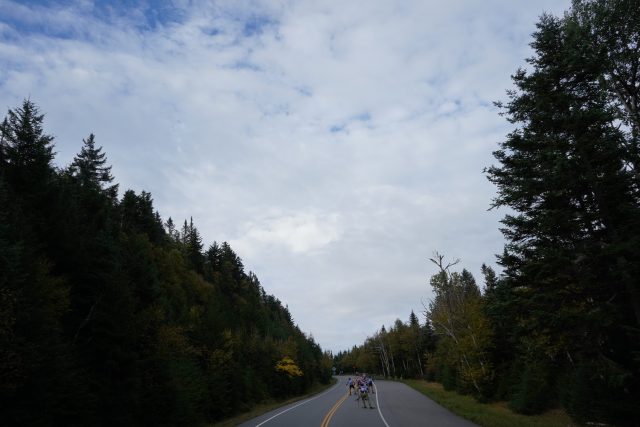
The Climb to the Castle follows the auto road on Whiteface Mountain in New York’s Adirondacks. At 4,867 feet, Whiteface is the fifth highest Adirondack peak. The toll road snakes upward for five miles at an eight percent average grade, gaining about 2300 vertical feet. Unlike the wet racers experienced in 2021, today the weather was dry, with a start time temperature around 50 degrees, and only a light breeze. Every two minutes, athletes went off in waves of 15.
Ripp led from the start, gradually dropping the rest of the first wave. Starting in the second wave, Izquierdo-Bernier bridged the gap up to the first wave around the halfway mark. “I stayed with [Ripp] all out to the top,” Izquierdo-Berniuer said. “In the last (kilometer) and a half, I put in a gap. That was fun to have someone to ski with.”
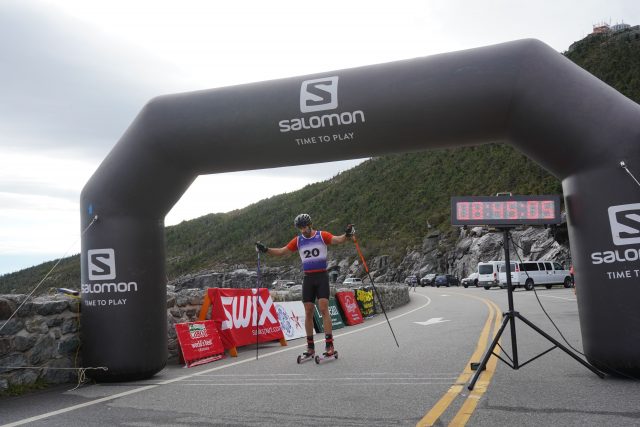
Not only was this Izquierdo-Bernier’s first win, it was his first trip to the Climb. “I had wanted to come a couple times, but it never fit in my training,” he said. He added that he didn’t have a specific race plan. “Try not to start too fast, that was the only plan. I didn’t the course and where I was going, so it was more controlled, and try to have fun.”
In this his second Climb to the Castle, Ripp applied lessons learned from last year’s race. “Last year, we got drawn out really quickly, and a lot of guys went out hard,” Rip said. “Last year, Jake Brown went really hard off the gate so you were trying to chase him down. But this year it was just me off the front. It was a little bit odd to have to lead and have to pace myself to try and figure out what felt like a good pace. But it was nice because Ricardo caught me about halfway through and then it was really fun racing with him. Around the last corner [Windy Corner] was where he dropped me.”
For Parke Chapin, it was also his first attempt at the Climb, finishing with a solid third place. “I didn’t know what the course was like, I just knew it was five miles,” he said. “So I started out with two other dudes in my wave. They were similar pace, and I pushed with one of them. Towards the top, I felt like there was more in me and I turned the dial a little more. A positive day out there.”
Women’s Climb
On the women’s side, Emma Page gapped the field at the start and never looked back. She admitted to having a tough point, mid-race: “There was definitely a hard part in the middle where I was getting bogged down, but one of the master skiers, he was really helpful and he was pushing me through it,” she said.
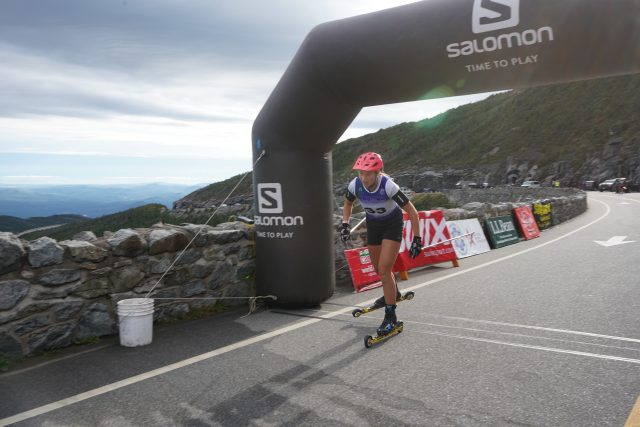
Like several other skiers, Page competed in (and won, as we shall see) the previous day’s sprint races at Mount van Hoevenberg. Was she fully recovered from the previous day’s effort? “I could definitely feel my legs, but I think that once I got through the warmup I was recovered and ready to go,” Page said.
“I wanted to not start out too hard because last year I started too hard and I ended up dying a bit,” she continued. “So I wanted to make sure that I eased my way into it. I went kind of hard in the start, to the first corner, and then I reeled it in a little because I realized I might need a little extra [energy]. But I did feel good the whole time, I never had to stop or slow down.”
Dolcie Tanguay also raced not only the previous day’s sprints, sprints, but also the biathlon race at the end of the day. She said that at the start of the Climb, she didn’t feel 100% recovered. “I did it last year for the first time, so I knew what to expect. This time, I paced it pretty consistently, which is an improvement. At the start, Emma Page went out way ahead, and I couldn’t hold on to her. That’s pretty much how it stayed. I caught a couple of people along the way. I just tried to keep it consistent.”
Master skier Kathy Schwenk commented on her finish: “I just appreciate the opportunity to race. I thank the race director and everyone who put it on. I started in a group of six, and I wanted to go just a little bit faster. So I got out of that and pretty much skied by myself the whole way.”
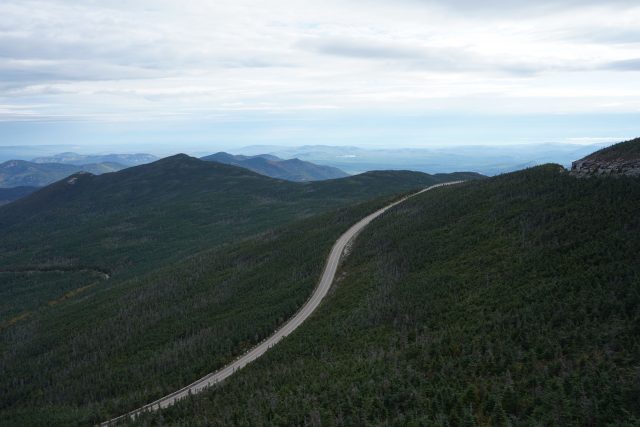
Once again this year, racers could sign up to ski classic technique in a separate category. New this year was a short course: Athletes could choose to start further up the mountain in a three-mile race. New England Nordic Ski Association (NENSA) Competition Director Justin Beckwith wrote, “We’ve always talked about a junior race that was a more appropriate distance and time – but why limit that to just juniors? Hopefully it boosts participation and gives folks a way to participate and get the experience without having to ski for an hour.”
Results: Climb to the Castle
Keys to the Castle (Saturday)
Rollerski Sprints and Rollerski Biathlon took place on Saturday, with action on the paved rollerski trails at Mount van Hoevenberg.
Men’s Freestyle Sprint
Sprints were contested on the 1500-meter sprint course that had seen use last winter. Instead of a typical “knockout” format, races were organized in a “king’s court” format. Individual start qualifiers determined athletes’ start positions with competitors racing four to a heat. Winners of each round moved up a bracket; second and third places remained in their bracket; fourth place finishers dropped to a lower bracket.
The action was fast and furious on the race course, as athletes accelerated to establish a lead before the first hill under the bridge. Some groups were incredibly tight—even in high-speed corners—while other heats saw athletes more spread out. There was less recovery time between rounds than in a normal sprint, and athletes approached recovery in a number of different ways. Most skied easy around the biathlon penalty loop, some did speeds, others changed into sneakers for a jog.
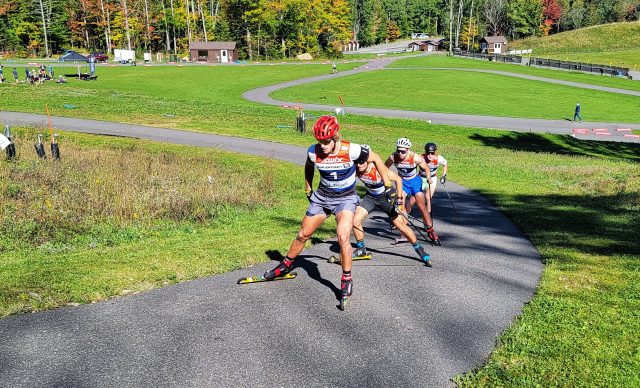
Fin Bailey of Stratton Mountain School (SMS) won the men’s sprint in dominating fashion, winning the prologue and every subsequent round. Through the morning, he never appeared fatigued. On the decisive climb to the high point of the course, he jump skated to build a gap from other skiers.
“I pretty much worked as hard as I can,” Bailey said. “Worked with Elvis [McIntosh] in our heats, had a little strategy that when we got to the big hill, we just hammered. That’s about it.”
The final climb on the sprint course leads to a sweeping downhill past the lodge, to a hard turn and an uphill finish. Owning that climb was key to Bailey’s strategy: “That was a pretty important part of the course,” Bailey said. “You come over the top of the hill, right at the big swooping downhill to the finish, you can get ahead… you’ll be set for the finishing straight.”
Elvis McIntosh, of GMVS, was hunting for a podium before he broke a pole in the final round. “First couple of rounds went pretty well,” McIntosh said. “I was working with Fin to keep it controlled and keep the pace good and we’d hammer up and over the final hill and sweep around the [downhill] corner into the finish. It was working pretty well and then in the final, my pole broke. Final didn’t go as well as I would have liked. It was a good, fun, race.”
Wyatt Teaford of SMS described his day: “I qualified fourth today. I moved up and down throughout the heats; I narrowly missed out on the final (getting) narrowly out-cornered on the last corner there. I think races like this are really great for preparing for winter.”
When everyone’s in a tight group on a small piece of real estate, do you get nervous? “I think it’s faster than a normal ski race, but I don’t think it’s scarier,” Teaford said. “Because everyone knows the etiquette of the course. No one’s gonna cut people off on corners where it could be dangerous. I think in skiing in the winter, everyone can get more physical in sprint races.”
Aidan Ripp of Paul Smith’s and Charles Martell of SMC-MNC came second and third in the men’s sprint.
Women’s Freestyle Sprint
Emma Page was first in the women’s sprint, followed by Dolcie Tanguay and Margot Nightingale in second and third respectively.
“It was great! I fell in the warmup, but other than that, it was great,” Page said.
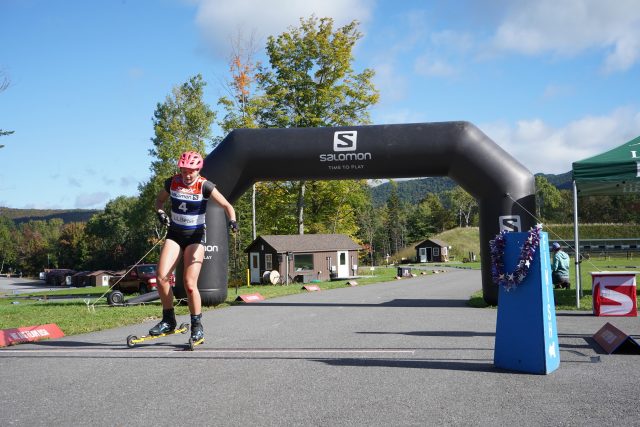
Asked how she manages her efforts to keep a consistent pace, Page said, “I’m usually really excited, so that’s actually my worst thing. I generally have worse energy towards the end. That’s what I worked on this summer. I’ve been working on doing speeds at the end of training, no matter what the training was. To try and get myself to push all the way to the end.”
Dolcie Tanguay took second place in the sprints before moving to the biathlon race later in the afternoon. “Usually, the point is to go pretty hard in the qualifier,” Tanguay said. “And then go from there. The high schoolers put on some pretty good competition today, so I just took each heat one at a time, went as hard as I could. The last one, I definitely slowed down a bit. But it was fun overall.”
Did she hold anything back for the biathlon? “Maybe a little. But the biathlon race is fairly short. I’m treating today more like a regular workout day, like two interval sessions.”
Results: Men’s and Women’s Sprints
Biathlon
After the sprints, the biathlon race was contested: five laps of a 940-meter loop (with 140-meter penalty loop) with the high point of the course occurring near the lodge. There were two prone and two standing rounds of shooting. NYSEF head biathlon coach observed Maddie Phaneuf explained the challenging conditions that Mount van Hoevenberg is known to serve up:
“Here at the new van Ho range, it’s a bit more challenging wind,” Phaneuf explained. “You might zero with a consistent wind from left to right, like we have right now, then it keeps shifting from dead wind or wind from right to left. The athletes really have to pay attention to the wind flags and know what their zeroing wind was and then make corrections throughout the race.”
Paul Smith’s College grabbed five of the six podium positions in the biathlon. Kaisa Bosek of Paul Smith’s won the women’s event, getting shouts from spectators as one shot clean in the first standing round. What went through her mind when she shot clean, then had a couple of misses on the final shooting? “First, you get excited, I think you leave the range a little faster,” Bosek said. “Then after not doing as well in the next round, it’s a mental game so you have to try to forget about that. At least mine [multi-miss standing] was on the last round so I didn’t have to think about it any longer. Then leave the range, try to finish the race strong and keep going.”
Dolcie Tanguay took second place in the women’s biathlon with Taylor Landrum, also of Paul Smith’s, finishing third.
Logan Jensen of Paul Smith’s was the men’s biathlon winner. He said of his race, “It was all right; it’s early in the season. [I’m] using it as a benchmark to hopefully keep working, and get better, faster, shoot better as the season goes on.”
On his race plan, Jensen said, “Today the course was super interesting. Super flat. I was working on getting my heart rate up, seeing how high I could shoot and stay accurate.”
Diego Shillaci of Paul Smith’s finished second among the men’s biathlon competitors, while Frazier Patterson of Mansfield Nordic finished third.
Results: Biathlon
Peter Minde
Peter Minde is a FasterSkier contributor and personal trainer specializing in functional strength and corrective exercise. Whether skiing, trail running, or cycling, he’s always looking to see what’s at the top of the next hill. From the wilds of north N.J., he skis for Peru Nordic. On Twitter @PeteMinde or at www.oxygenfedsport.com.


